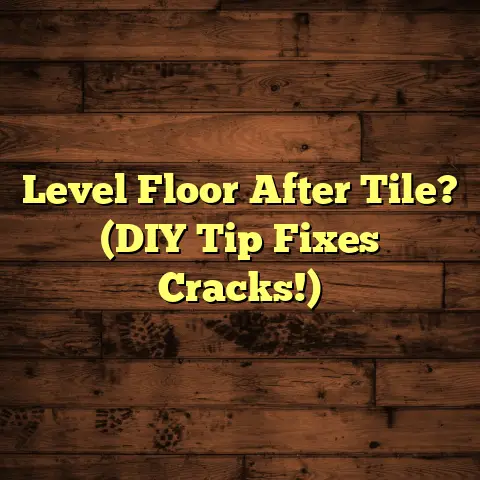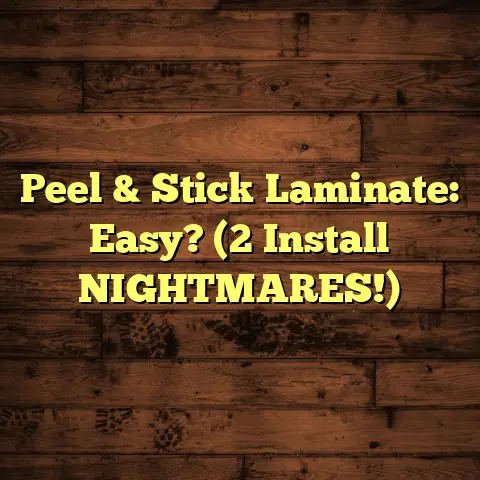Pro Tile Floor Cleaner? (Top Secret Tip!)
I’m Mike, a flooring contractor with over 20 years in the trenches. I’ve seen it all, from the glorious gleam of freshly laid tile to the downright disastrous effects of neglect.
Tile flooring, it’s a classic choice, right?
It’s durable, looks fantastic, and seems easy to maintain. But let me tell you, there’s a whole world of difference between “seems easy” and actually achieving that showroom shine, year after year.
Let’s dive into the tradition of tile floor care, understanding the nuances, and revealing a top-secret tip that’ll have your floors looking better than ever.
The Tradition of Tile Flooring Care
Tile flooring has been a staple in homes and public spaces for centuries. Think about it: the intricate mosaics of ancient Rome, the colorful ceramic tiles of Spanish haciendas, even the simple, functional tiles in your local grocery store.
Tile’s appeal lies in its durability, aesthetic versatility, and perceived ease of maintenance.
But here’s the thing: just because tile can last for decades doesn’t mean it will without proper care.
I’ve seen stunning tile installations fall into disrepair simply because homeowners didn’t know the right way to clean and maintain them.
That’s where specialized cleaners come in.
They’re not just about removing surface dirt; they’re about preserving the integrity and beauty of your tile for the long haul. Ready to learn more? Let’s jump in!
Section 1: Understanding Tile Flooring
Okay, before we get to the juicy secret, let’s talk tile. Not all tiles are created equal, and knowing what you’re working with is half the battle.
1.1 Types of Tile Flooring:
There are several types of tile flooring, each with its own unique properties and cleaning requirements.
-
Ceramic Tile: The most common and affordable option. It’s made from clay, fired in a kiln, and then often glazed. Great for general use.
-
Porcelain Tile: A denser, more durable type of ceramic tile. It’s less porous, making it more resistant to water and stains. Ideal for high- traffic areas and bathrooms.
Fun Fact: Porcelain tile is often rated using the Porcelain Enamel Institute (PEI) scale. A higher PEI rating indicates greater resistance to abrasion.
-
Natural Stone Tile: This includes granite, marble, slate, limestone, and travertine. Each stone has its own unique characteristics and requires specific cleaning and sealing protocols.
-
Vinyl Tile: A synthetic material that mimics the look of other tiles. It’s water-resistant, affordable, and easy to install.
Did you know? Luxury Vinyl Tile (LVT) and Luxury Vinyl Plank (LVP) are increasingly popular due to their realistic appearance and durability.
The type of tile you have directly impacts the cleaning methods and products you should use.
For instance, acidic cleaners can etch natural stone, while abrasive cleaners can scratch the surface of glazed ceramic tiles.
1.2 Common Tile Flooring Issues:
Even the most durable tile isn’t immune to problems. Here are some common issues I see all the time:
-
Stains: Coffee spills, muddy footprints, pet accidents – you name it, I’ve seen it stain a tile floor.
-
Grime Buildup: Over time, dirt, grease, and soap scum can accumulate on the surface of the tile and in the grout lines, making your floor look dull and dingy.
-
Wear and Tear: High-traffic areas can experience wear and tear, leading to scratches, scuffs, and faded colors.
-
Grout Problems: Grout is porous and can easily absorb stains and dirt. Cracked or crumbling grout not only looks bad but can also lead to water damage.
Neglecting proper cleaning can lead to irreversible damage. Stains can become permanent, grout can disintegrate, and the overall appearance of your floor can suffer.
Trust me, a little preventative maintenance goes a long way! So, what’s next? Let’s talk about choosing the right cleaner!
Section 2: The Importance of Choosing the Right Cleaner
Alright, so you know what kind of tile you have and what problems you’re facing. Now, let’s get down to the nitty-gritty: choosing the right cleaner.
This is where a lot of homeowners go wrong.
They grab whatever’s cheapest at the store, or they assume that all cleaners are created equal. Big mistake!
2.1 Chemical vs. Natural Cleaners:
The age-old debate: chemical vs. natural. Let’s break it down.
-
Chemical-Based Cleaners: These often contain harsh chemicals like bleach, ammonia, and acids. They can be very effective at removing tough stains and grime, but they also come with some serious drawbacks.
- Pros: Powerful cleaning action, readily available, often cheaper.
- Cons: Can be harmful to your health (skin irritation, respiratory problems), can damage certain types of tile, environmentally unfriendly.
-
Natural Cleaners: These use ingredients like vinegar, baking soda, lemon juice, and essential oils. They’re generally safer for your health and the environment, but they may not be as effective on tough stains.
- Pros: Safer for health and environment, gentle on tile, often smell pleasant.
- Cons: May not be as effective on tough stains, can require more elbow grease.
I always advise homeowners to consider the environmental impact and potential health risks of using harsh chemicals.
According to the EPA, many household cleaning products contain volatile organic compounds (VOCs) that can contribute to indoor air pollution.
If you have kids or pets, natural cleaners are usually the safer choice.
2.2 Why Pro Tile Floor Cleaner Stands Out:
Okay, so where does “Pro Tile Floor Cleaner” fit into all of this? Well, I’ve been testing and using different tile cleaners for years, and I’ve found that this one strikes a great balance between effectiveness and safety.
-
Formulation: It’s formulated with a blend of surfactants, enzymes, and chelating agents that work together to break down dirt, grease, and stains without harsh chemicals.
-
Versatility: It can be used on a variety of tile types, including ceramic, porcelain, and even some natural stones (always test in an inconspicuous area first!).
-
Advantages: It’s pH-neutral, biodegradable, and doesn’t leave behind any residue. Plus, it has a pleasant, light scent.
I’ve seen it tackle everything from stubborn coffee stains to ground-in dirt with ease. And, honestly, that’s why I’m recommending it.
Here’s a quick testimonial from a client:
“Mike recommended Pro Tile Floor Cleaner for my kitchen tile, and I’m so glad he did! It got rid of stains I thought were permanent, and my floors look brand new again.” – Sarah J.
But here’s the kicker…
There’s a secret tip that takes its cleaning power to the next level. Are you ready to hear it? Let’s go!
Section 3: The Top Secret Tip for Using Pro Tile Floor Cleaner
Alright, folks, this is the moment you’ve been waiting for. The top-secret tip that will revolutionize your tile floor cleaning routine.
Drumroll, please…
3.1 Unlocking the Secret:
The secret is… warm water and dwell time!
Yep, it’s that simple. But the science behind it is pretty cool.
-
Warm Water: Warm water helps to loosen dirt and grime more effectively than cold water. It also activates the cleaning agents in the Pro Tile Floor Cleaner, making them work even harder.
-
Dwell Time: Dwell time refers to the amount of time you let the cleaner sit on the surface of the tile before wiping it away. This allows the cleaner to penetrate deep into the pores of the tile and grout, breaking down stubborn stains and grime.
I’ve found that a dwell time of 5-10 minutes can make a huge difference in the final result.
3.2 Step-by-Step Guide to Using Pro Tile Floor Cleaner with the Secret Tip:
Okay, let’s put this secret tip into action. Here’s a step-by-step guide to using Pro Tile Floor Cleaner with warm water and dwell time:
- Preparation: Sweep or vacuum the floor to remove loose dirt and debris.
- Mix the Solution: Mix Pro Tile Floor Cleaner with warm water according to the manufacturer’s instructions. I usually use a ratio of 1 ounce of cleaner per gallon of water.
- Apply the Cleaner: Use a mop or sponge to apply the solution to the floor. Make sure to saturate the grout lines.
- Dwell Time: Let the solution sit on the floor for 5-10 minutes. Don’t let it dry completely.
- Scrub (Optional): If you have stubborn stains or heavily soiled grout, use a scrub brush or grout brush to gently scrub the affected areas.
- Rinse: Rinse the floor thoroughly with clean, warm water.
- Dry: Use a clean towel or mop to dry the floor. You can also use a fan to speed up the drying process.
Pro Tip: For heavily soiled grout, make a paste of Pro Tile Floor Cleaner and baking soda. Apply the paste to the grout lines, let it sit for 15-20 minutes, then scrub with a grout brush and rinse.
Post-Cleaning Maintenance:
- Place mats and rugs in high-traffic areas to protect the tile from wear and tear.
- Wipe up spills immediately to prevent staining.
- Regularly sweep or vacuum the floor to remove loose dirt and debris.
By following these steps and incorporating the secret tip of warm water and dwell time, you’ll be amazed at how clean and shiny your tile floors can be!
Section 4: Maintenance Tips for Long-Lasting Tile Floors
Cleaning is crucial, but maintenance is the key to long-lasting beauty. Let’s talk about keeping those tiles pristine.
4.1 Regular Cleaning Routines:
Consistency is your friend! Here’s a cleaning schedule I recommend to my clients:
- Daily: Sweep or vacuum to remove loose dirt and debris.
- Weekly: Mop with Pro Tile Floor Cleaner and warm water.
- Monthly: Deep clean grout lines with a grout brush and a paste of Pro Tile Floor Cleaner and baking soda.
- As Needed: Spot clean spills and stains immediately.
Preventative Measures:
- Mats and Rugs: Place mats at entrances to trap dirt and moisture. Use rugs in high-traffic areas to protect the tile from wear and tear.
- Furniture Pads: Use furniture pads under the legs of chairs and tables to prevent scratches.
- Avoid Abrasive Cleaners: Never use abrasive cleaners or scrub brushes on glazed tile, as they can scratch the surface.
4.2 Dealing with Specific Stains:
Okay, let’s get specific. Here’s how to tackle some common stains:
- Oil Stains: Blot up as much oil as possible with a clean cloth. Apply a paste of baking soda and water to the stain, let it sit for several hours, then scrub and rinse. Pro Tile Floor Cleaner can then be used.
- Wine Stains: Blot up the spill immediately. Apply a mixture of hydrogen peroxide and baking soda to the stain, let it sit for a few minutes, then scrub and rinse.
- Dirt Stains: Clean with Pro Tile Floor Cleaner and warm water, using a scrub brush to loosen the dirt.
- Pet Stains: Clean with Pro Tile Floor Cleaner and warm water. For stubborn stains, use an enzymatic cleaner designed for pet stains.
Important Note: Always test any cleaning solution in an inconspicuous area before applying it to the entire floor.
Section 5: Conclusion
So, there you have it! The secrets to pro-level tile floor cleaning, revealed.
We’ve covered everything from understanding different tile types to choosing the right cleaner and tackling specific stains.
Remember, the key takeaways are:
- Choose the right cleaner for your tile type.
- Use warm water to enhance cleaning power.
- Allow for dwell time to penetrate deep into pores.
- Establish a regular cleaning routine.
- Address stains promptly.
By following these tips and using Pro Tile Floor Cleaner, you can keep your tile floors looking beautiful for years to come.
Don’t underestimate the power of a well-maintained tile floor. It can transform the look and feel of your entire home.
Embrace this knowledge, put it into practice, and enjoy the compliments you’ll receive on your sparkling clean tile floors.
Happy cleaning!





